m (Fixing size) |
m (→Formation) |
||
| Line 50: | Line 50: | ||
Therefore, [[Aulsur (clan)|Omus' clan]] came into prominence. Likewise, Omus was set up as the head of his clan. Because of this, Dezlar became known as [[Aulsur|The Aulsur]]. Omus established a strict dictatorship. His soldiers made sure the various clans honored the Oaths. But The Aulsur was not content to rule Cilwelli. He dreamed of creating a new empire that would dwarf the Infinite Empire. Therefore, he named the new government the Great Infinite Cilwellian Empire. To accomplish his ends, Dezlar began borrowing technology from his former masters to create a basic fleet of starfighters. These ships went to attack [[Hustia]], a nearby planet which had also recently gained her independence. |
Therefore, [[Aulsur (clan)|Omus' clan]] came into prominence. Likewise, Omus was set up as the head of his clan. Because of this, Dezlar became known as [[Aulsur|The Aulsur]]. Omus established a strict dictatorship. His soldiers made sure the various clans honored the Oaths. But The Aulsur was not content to rule Cilwelli. He dreamed of creating a new empire that would dwarf the Infinite Empire. Therefore, he named the new government the Great Infinite Cilwellian Empire. To accomplish his ends, Dezlar began borrowing technology from his former masters to create a basic fleet of starfighters. These ships went to attack [[Hustia]], a nearby planet which had also recently gained her independence. |
||
[[Image:Spacegladiators.jpg|thumb|left|The raid on Hustia|200 px]] |
[[Image:Spacegladiators.jpg|thumb|left|The raid on Hustia|200 px]] |
||
| − | However, The Aulsur underestimated Hustia's native species, the [[Urgal]]s. The attacking Cilwelli ships were shot out of the sky. The pilots who survived were killed by the Urgal warriors once they reached the surface. The Cilwelli people were devastated by the failed attack. Some clans leaders even considered defying the Five Oaths in order to end the war. Dezlar knew he could have a rebellion on his hands. Therefore, he made an alliance with various priests and holy men. Together, they worked out a way to turn the invasion of Hustia into a holy crusade. The priests backed Omus up and used their religious influence to encourage the people to do the same. In return, The Aulsur gave the holy men power and wealth. Now with religious backing, Omus sent even more troops to Hustia. This time, the Cilwelli soldiers overran the Urgals. |
+ | However, The Aulsur underestimated Hustia's native species, the [[Urgal]]s. The attacking Cilwelli ships were shot out of the sky. The pilots who survived were killed by the Urgal warriors once they reached the surface. The Cilwelli people were devastated by the failed attack. Some clans leaders even considered defying the Five Oaths in order to end the war. Dezlar knew he could have a rebellion on his hands. Therefore, he made an alliance with various priests and holy men. The holy men were [[starwars:Shaman|shamans]] who had a great deal of authority over Cilwellian life during that period. Together, they worked out a way to turn the invasion of Hustia into a holy crusade. The priests backed Omus up and used their religious influence to encourage the people to do the same. In return, The Aulsur gave the holy men power and wealth. Now with religious backing, Omus sent even more troops to Hustia. This time, the Cilwelli soldiers overran the Urgals. |
Perhaps in an attempt to show dominance or with the idea of retribution, the Cilwelli treated the Urgals fairly harshly. Many non-combatants were executed. Those who were not killed were taken back to Cilwelli as slaves. Having taken Hustia, Omus sent his ships to scout out unknown regions. None of the ships returned. There simply weren't any other planets within the starfighters' limited range. |
Perhaps in an attempt to show dominance or with the idea of retribution, the Cilwelli treated the Urgals fairly harshly. Many non-combatants were executed. Those who were not killed were taken back to Cilwelli as slaves. Having taken Hustia, Omus sent his ships to scout out unknown regions. None of the ships returned. There simply weren't any other planets within the starfighters' limited range. |
||
| Line 61: | Line 61: | ||
For the next five years, Zargayus began uniting the clans one by one. Some were conquered by Zargayus' [[Zargi]]. Other clans willing joined the Cilwellian Empire. In at least two cases, Zargayus won control of a clan by marrying into the patriarch’s family. In order to dissolve old loyalties, Zargayus reorganized the clans. Soon, the clans began to look more like castes. However, Zargayus' policies would set the template for the later generations. |
For the next five years, Zargayus began uniting the clans one by one. Some were conquered by Zargayus' [[Zargi]]. Other clans willing joined the Cilwellian Empire. In at least two cases, Zargayus won control of a clan by marrying into the patriarch’s family. In order to dissolve old loyalties, Zargayus reorganized the clans. Soon, the clans began to look more like castes. However, Zargayus' policies would set the template for the later generations. |
||
| + | |||
===Holy wars=== |
===Holy wars=== |
||
Several Cilwellians were not happy with the new state religion. Many tried to defy the government by continuing to follow their old faiths. The [[Crex]] were orer to eliminate all non-conformists. Hundreds of heathens were executed or beaten before all out rebellion took place. The relatively large scale of the rebel attacks caught the government off guard. The heathen armies stormed Zargayus' palace and took him hostage. |
Several Cilwellians were not happy with the new state religion. Many tried to defy the government by continuing to follow their old faiths. The [[Crex]] were orer to eliminate all non-conformists. Hundreds of heathens were executed or beaten before all out rebellion took place. The relatively large scale of the rebel attacks caught the government off guard. The heathen armies stormed Zargayus' palace and took him hostage. |
||
Revision as of 16:07, 27 October 2008
By blood this Empire was created. By blood this Empire will thrive. By blood this Empire shall fall.
—Zargayus
The Holy Cilwellian Empire, originally known as the Great Infinite Cilwellian Empire, or simply the Cilwellian Empire, or the Empire, was a pre-Republic civilization which ruled over the Cilwelli sector. The empire was ruled by a series of strict laws created by the Aulsur and enforced by the Crex. These laws were dictated by the Zargayus Doctrine, a philosophy which taught that everyone had but one purpose in life. Therefore, the Cilwellian Empire was made up of several clans. Each of these clans had their own local government which answered to the monarchy. Traditionally each clan had specific tasks and responsibilities within Cilwellian society.
The Cilwellian Empire began when the Cilwelli rebelled against the Infinite Empire. The slaves killed their former masters and established an independent government. This new government set out to create their own empire. The nearby planet of Hustia was the first to fall. However, the crusade was generally considered a failure by most historians. The Cilwellians were considered too technologically primitive to be able to conquer large amounts of worlds.
The Cilwellian Empire was reorganized by Zargayus. The reformation centered around Zargayus' new religion and the Zargayus Doctrine. From then on, the Ciwelli followed a strict hereditary caste system. During Zargayus' reign, a feeling of superiority came over the Cilwellians. As a result, other species were enslaved or killed. This sentiment would outlive the Holy Empire. Urgals were particularly mistreated.
The Holy Cilwellian Empire would remain isolated until the Hutt-Xim War. The armies of Xim attacked Cilwelli, killing many of the native populates. Up against a numerically and technologically superior force, the proud Cilwellians had to call for aid. The Hutt Empire, who was also fighting Xim, agreed to help the Holy Empire. Though the Hutts managed to save the Cilwelli from the armies of Xim, it came at a heavy cost. The Cilwellians were forced to give up their land and authority to the Hutt Empire.
History
Formation
The Infinite Empire had brought several Human slaves to the remote planet of Cilwelli. These slaves married many of the native Fortress builders, resulting in a unique species, called the Cilwelli. For several decades, the Cilwelli remained imprisoned by the Rakata. The Cilwelli banned together in series of family groups. As the Infinite Empire began to decline, a slave named Dezlar Omus led a rebellion against the Rakata. Omus and his followers led multiple raids against their enemies, resulting in heavy casualties for both sides. However, the raids won Dezlar fame throughout Cilwelli. Soon he had a large following. The Cilwellian freedom fighters drove the Infinite Empire off the planet in a matter of months.
With their freedom won, the Cilwelli clans swore Five Oaths to Dezlar Omus. These were the Five Oaths: To remain loyal to Dezlar Omus as long as he live, to honor the laws and authority of Dezlar Omus, to fight for Dezlar Omus is times of war, to respect the authority of Dezlar Omus' clan, and to honor Dezlar Omus' heir.
Therefore, Omus' clan came into prominence. Likewise, Omus was set up as the head of his clan. Because of this, Dezlar became known as The Aulsur. Omus established a strict dictatorship. His soldiers made sure the various clans honored the Oaths. But The Aulsur was not content to rule Cilwelli. He dreamed of creating a new empire that would dwarf the Infinite Empire. Therefore, he named the new government the Great Infinite Cilwellian Empire. To accomplish his ends, Dezlar began borrowing technology from his former masters to create a basic fleet of starfighters. These ships went to attack Hustia, a nearby planet which had also recently gained her independence.
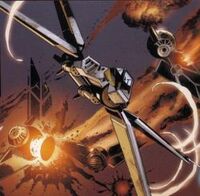
The raid on Hustia
However, The Aulsur underestimated Hustia's native species, the Urgals. The attacking Cilwelli ships were shot out of the sky. The pilots who survived were killed by the Urgal warriors once they reached the surface. The Cilwelli people were devastated by the failed attack. Some clans leaders even considered defying the Five Oaths in order to end the war. Dezlar knew he could have a rebellion on his hands. Therefore, he made an alliance with various priests and holy men. The holy men were shamans who had a great deal of authority over Cilwellian life during that period. Together, they worked out a way to turn the invasion of Hustia into a holy crusade. The priests backed Omus up and used their religious influence to encourage the people to do the same. In return, The Aulsur gave the holy men power and wealth. Now with religious backing, Omus sent even more troops to Hustia. This time, the Cilwelli soldiers overran the Urgals.
Perhaps in an attempt to show dominance or with the idea of retribution, the Cilwelli treated the Urgals fairly harshly. Many non-combatants were executed. Those who were not killed were taken back to Cilwelli as slaves. Having taken Hustia, Omus sent his ships to scout out unknown regions. None of the ships returned. There simply weren't any other planets within the starfighters' limited range.
Only a few years after the conquest of Hustia, Urgals rebelled against the Cilwellian Empire. Omus led his army into battle. The Urgals were vastly outnumbered. The battle was quick. Cilwellian forces drove the Urgals back. However, while retreating, an Urgal warrior fired at the Cilwellian front line. The blaster bolt hit The Aulsur in the neck. He died soon after.
Omus died childless. Therefore, his cousin, Zargayus, was chosen to lead Empire. However, few clans acknowledged Zargayus as the rightful ruler. With Dezlar Omus dead, many clan leaders felt that the Five Oaths no longer applied. As a result, many clans declared independence. Zargayus believed it was his life mission to unite the clans and created a foundation for the next generation. This first step was to promote his new religion. Missionaries converted many Cilwelli. It was Zargayus' hope that this new faith would unite the clans. It was under Zargayus that the term Holy Cilwellian Empire was first used.
Zargayus then established the Zargayus Doctrine. The Doctrine stated that all people had one life quest. Furthermore, the Doctrine declared that the only way to be truly happy was to embrace one's role in life. Therefore, Zargayus began issuing life quests to various clans. For example, one clan might have the role of farmer, while another's role was to defend the Holy Empire.
For the next five years, Zargayus began uniting the clans one by one. Some were conquered by Zargayus' Zargi. Other clans willing joined the Cilwellian Empire. In at least two cases, Zargayus won control of a clan by marrying into the patriarch’s family. In order to dissolve old loyalties, Zargayus reorganized the clans. Soon, the clans began to look more like castes. However, Zargayus' policies would set the template for the later generations.
Holy wars
Several Cilwellians were not happy with the new state religion. Many tried to defy the government by continuing to follow their old faiths. The Crex were orer to eliminate all non-conformists. Hundreds of heathens were executed or beaten before all out rebellion took place. The relatively large scale of the rebel attacks caught the government off guard. The heathen armies stormed Zargayus' palace and took him hostage.
The non-conformist rebels took Zargayus into the Cilwelli desert. Originally, they hoped to use the theocrat as a bargaining chip, but Zargayus refused to be a puppet. He ordered his comrades not to negotiate with the heathen. In their rage, the rebels tortured Zargayus. The pagans saw the brutal secession as justice.
Meanwhile, the government was placed under the control of Zargayus' siblings. The temporary government was deadlocked in debate. Some wanted to use all the Empire's resources to rescue Zargayus. Others wanted the Aulsur to stay in enemy hands, so that they could control the Cilwellian Empire. Still others, thought it would be more honorable to try to avenge Zargayus.
Fighting brakes out in Cilwelli City
However, the Auslurs did not have time to debate. Rioting, fueled by religious hatred, broke out in the capital. Lawmen were unable to keep the peace. Warriors stationed themselves around he palace to prevent the mob from overthrowing the government. Zargayus' wife was unwilling to wait for the government to regain control of situation. Knowing that her husband was in danger, she covertly sent a team of Zargi to find and recover the Auslur. The strike team trailed the insurgents to their mountain hideaway. After brief fighting, they managed to free their leader. However, Zargayus was unable to recover from the wounds he received while being tortured. He died a few days after returning to his home.
According to Cilwellian law, Zargayus' siblings elected his replacement. A young warriors named Oloni was chosen. The Aulsurs hoped to manipulate the youthful Cilwelli so that they could use to current unrest to their advantage. However, Oloni proved to more headstrong than this his peers had anticipated. Oloni was in desert when a messenger told him that he had been elected Aulsur. Quickly, he marshaled an army and went to Cilwelli. The soldiers crushed the riot and established order in the city.
Before the rioters could flee the city, Oloni had the gateways sealed. He then called all the people in Cilwelli City together. He wanted to make clear that the teachings of Zargayus would be followed as long as he was High Aulsur. Oloni had his serfs erect a giant statue of Graef, the central deity in Zargayus' religion. He then commanded everyone in the city to bow before the golden idol. All those who refused were cast into a fiery pit. He then sent proclamations throughout Cilwelli, telling local leaders to do the same. At least one patriarch refused to comply. Therefore, Oloni took his army and killed the rebellious leader and his followers. A puppet ruler was then established.
Several pagans rallied against Oloni. They attacked the river city of Omzli and captured valuable nova crystal mines. The victory caused many anti-Zargayusists to join the rebellion. Soon Omzli was filled with insurgents. So large was the enemy force, that Oloni feared his army would be unable to defeat the rebels. Therefore, he sent several Urr upstream of Omzli. The Urr builders created a dam to block the river. The dam formed a large lake which flooded Omzli and buried it in water. Many rebels died. The rest fled into the mountains.
Oloni and his army pursued the fleeing pagans and the two sides collided in a small canyon. The fighting was intense, but the loyalists had numbers on their side. The overwhelmed rebels finally surrendered. However, the battle did not end without taking its toll on Oloni. During the fighting, a stray blaster bolt hit him in the chest. He and his men were later buried at Cilwelli City.
Age of anarchy
After Oloni's death, the Aulsur once again met to elect a replacement. After weeks of debate, Zerela was chosen, making her the Empire's first female head of state. Zerela revolutionized the government. She was a strong believe in clan autonomy. Therefore, she allowed the clans to essentially govern themselves without any interference from the federal government. This allowed the clan rulers to gain more power.

A Crex and Zargi battle.
A fight over a nova crystal rich land resulted in a war between the Zargi and the Crex. The Zargi had established a military base on the region. However, the Crex, who acted as the Empire's law enforcement, discovered that clan leaders were taking the valuable minerals from the land. The Crex moved into the Zargi military base and imprisoned many of the army officers. The Zargi accused the Crex of trying to take the crystals as their own. Therefore, they resounded by attacked the captured army base. The Zargi warriors slaughtered the Crex and reclaimed the valuable territory. The next day, the Crex declared the Zargi clan an enemy of the state.
While not involved, the High Clans were extremely concerned that the war between the Crex and the Zargi would get out of hand. Together, the two clans controlled all of the Cilwellian Empire's military might. The Aulsurs realized that such a war could cripple the Imperial defense system. They begged Zerela to intervene. However, her policy of clan sovereignty caused her to stay out of the crisis. Meanwhile, the two warring clans began looking for aid. Several Middle Clans joined in the battles for various sides. Some Aulsurs, in an attempt to end the war, went rogue and began choosing sides. They hoped that victory would be quick and that the war would soon end.
The Cilwellian economy soon went into ruin. The warring clans were trampling over the pacifist families. The neutral clans pressed the Auslur to act, but again Zerela refused. A movement arose among Cilwelli called the Unity movement. The movement sought to unite the clans and end the blood shed. However, the movement did not gain support in the upper levels of the Cilwellian government. Some clan leaders, who were enjoying their new power, attempted to halt the movement. Unity Party leaders were assassinated and followers scared off. Meanwhile, the war was depleting the empire's recourses and forcing the people into debt.
In order to end the destructive conflict, lower-level Aulsurs secretly met with Zargi and Crex leaders. After six weeks of negotiations, the Aulsurs were able to use their religious authority to convince both sides to sign a peace treaty.
Hutt-Xim War
In 25,105 BBY, a war erupted between the Hutt Empire and the armies of Xim. At first, Cilwelli stayed out of the conflict. This changed when Xim's war-robots landed on Cilwelli and began scouting the world. Xim hoped to use Cilwelli as an outpost so that he could attack the Hutt forces from the rear. The war-robots encountered a small Cilwellian village. The superstitious villagers saw the strange droids as demons sent by Graef to slay them. Therefore, the villagers armed themselves and attacked the robots. Many villagers were slaying by the battle hardened machines. However, the Cilwellians managed to drive off the robots.
Xim saw the skirmish as a declaration of war. He sent more war-robots to Cilwelli. The Zargi were called to arms and soon war engulfed the planet. The two armies first met in a valley outside Cilwelli City. The Zargi had a better understanding of the terrain and they were able to out smart their robotic foes. Therefore, the first battle resulted in a victory for the Cilwelli.

A droid similar to the ones that attacked Cilwelli.
However, Xim was more technologically advanced and retaliated with even great fury. Soon Cilwelli was flooded with enemy war-robots. The Zargi were overwhelmed. Before long, Cilwelli was all but under the control of Xim's Empire. But Zerela, timid as she was, refused to take action. Therefore the Vranga removed her from office, claiming that she was not worthy of her divine post.
Zerela was replaced by Ozlu Cu who believed it was his life quest to save the Cilwelli from Xim's forces. He first tried to do this by marshaling the Zargi and launching a surprise attack on Xim. But the war-robots were too well equipped and more dangerous than he realized. The attack was considered a disaster for the Cilwelli.
Therefore Ozlu began rethinking his strategy. He realized that the superior Hutt armies were also at war with Xim. So he met with Hutt ambassadors, who were eager to accept Ozlu's offer. In exchange for weapons, ships, and founds, the Cilwellians agreed to fight for the Hutts. Though they did not realize it at the time, they had just sold themselves into slavery. However, the treaty did save them from the invasion forces. With assistance of Hutt troops and weaponry, the Cilwelli struck back. Xim's forces were caught off guard by the sudden wave of enemy troops. Soon the war-robots were fleeing from the overwhelming enemy forces.
The Cilwellians rejoiced over their victory. Cu even adopted some of the Hutts into the Aulsur clan. But their joy was short lived. The Hutts soon required that the Cilwelli live up to their end of the bargain. Hutts force various Cilwellians to fight with them during the Battle of Vontor. Many Zargi were killed during the battle. Though the battle marked the destruction of Xim's Empire, it also marked the end of Cilwellian sovereignty.
Culture
Clans
The clans of Cilwellian society were often categorized as castes by offworlders. It seemed to many that caste better described the levels of cultural rank which had been established long before the Old Republic. However, there were distinct differences between the Cilwelli clans and tradition castes. Namely, a person's place in society was determined by family origin. Likewise it was possible to move out of the lower clans through adoption, a common practice on Cilwelli.
The clan system was an expansion of the Zargayus Doctrine, which said that every person was to have but one role in life. This meant that each clan was to have a specific task for which they were responsible. The Zargayus Doctrine stated that the only way to find true happiness was to make the most of one's role in life.
Each clan was ruled by a patriarch. Usually an aged male, the patriarch was to provide for the clan in exchange for their loyalty. The patriarchs governed the clan until they died. After which, a replacement would be chosen by the former patriarch’s children.
The clans were divided into three major groups, High Clans, Middle Clans, and Low Clans. According to custom, clan members could mingle with separate clans of the same group.
High Clans
Aulsur was the ruling clan of the Cilwelli. Likewise, their patriarch acted as the planetary monarch. The name Aulsur meant Children of the Gods, for it was said that clan members were the last mortal descendants of the deities. Therefore, the Aulsur had complete authority over all other clans, save the Vranga. After the Hutts captured Cilwelli, the Aulsur became diluted by their new alien "brothers", whom the peace-seeking patriarchs adopted into their clan. As the religious clan, the Vranga, or Seers, were extremely powerful in Cilwellian society. Their spoken word was regarded as the undeniable truth and the very ground upon which they stepped was considered sacred. The Seers were often called warlocks, because of their mystical beliefs and abilities.
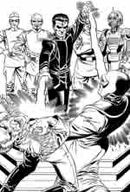
A warlock during the Galactic Civil War.
The clan was composed exclusively of Force-sensitives. Therefore when a child from another clan was discovered to have a high midi-chlorian count, a witch (a female warlock) would take the child from its parents and raise it. At the same time, a male Vranga would begin training the child in the ways of the Force and the Cilwelli faith.
Because of their religious beliefs, most warlocks preferred the dark side. According their faith, the dark side was a gift from the god of darkness, Graef. The dark god expected the "gifted" to use the ability to promote self-sacrifice and physical pain in order to guaranty a place in the Afterlife. Those who used the light side were said to gifted by Hayweh. Because Hayweh was the god of the Afterlife, the warlocks believed that Jedi and other light siders to be zombies from the next life.
The Crex, or Hands, were the enforcers of the law. They had direct authority from the Aulsur to use any means necessary to keep the peace. The Crex would usually punish suspected criminals using means that were design to humiliate, as much as inflict pain. Over time the Crex became corrupt and power-hungry. Because of their "divine" power it was easy to eliminate possible threats. Each Crex would carry an ax and a rod. The ax was for capital punishment and the rod for corporal. The clan members would adorn themselves in black robes and masks. These garments were called urge and were said to be sacred. According to tradition, the robes were created by one of Greaf's demons and would strike fear into the hearts of all who gazed upon them.
Middle Clans
The most honored of the Middle Clans, the Zargi, or Blood-soaked Ones, were still given the same respect and honor as their High Clan peers. As the warrior clan, the Zargi were counted among the greatest fighters in the Galaxy. Their training was intense and their vigor and zeal were unparalleled. Each Zargi child, regardless of gender, was trained in the art of combat from a very young age. Hardship was all they ever knew, and yet they took pride in their pain. The Blood-soaked Ones had no room for weaklings. Therefore weakness was beaten out of the children. These beatings also taught the young warriors to embrace anger so that they could fight with greater passion. After the Hutt-Xim War, the Zargi became the personal bodyguards of their new Hutt masters. However, as years progressed, and the Cilwelli's loyalty to the Hutts began to falter, many warriors forsook their previous overlords and took jobs as mercenaries.
Considered lesser warriors, the Hyt were hunters and animal slayers. They were the only clan allowed to hunt the sacred Kull. Like the Zargi, they were characterized for their bravery, but to a lesser extent as the warriors. Many Hyt were later adopted into the Zargi family. The clan would trade their kills to the other Middle and Low Clans and give them as tribute to the High Clans. The Hyt would ordain themselves in red and black paint. The red paint represented the blood of the kills. The black symbolized their respect for the creatures they hunted. These marks made them instantly recognizable in Cilwellian culture.
The counterparts of the Hyt, the Sevvel were farmers and planters. They helped tame the wild landscape of Cilwelli and grew all manner of fruits and vegetables. Like the Hyt, they would sell their produce to their equals and give it to their superiors. Of the Middle Clans, the Sevvel were probably the best educated. They studied science and biology so that they could maximize their yield. Using a drop irrigation system, the farmers would collect water from the mountains in large tubes. The water would then flow down to the highly populated valleys, were it filtered through rubber tubes which steadily "leaked" in order to water the farms. The Sevvel prided themselves in "making the desert bloom."
The Urr were a clan of builders and masons. Charged with the secrets of the Fortress builders, they built grand cities and temples that were legendary for their time. Using tools that were generally considered primitive, the Urr, or Mound-makers, crafted huge structures, many of which lasted well into the Legacy era. They built the homes of the greatest kings and the lowest peasants. Likely the numerically largest clan, the Urr lived among the other clans, in the homes they built. They were recognized by their abnormal physical strength, which was the result of many long hours of work. The Mound-makers took pride in their ability to work for hours on end without resting. Some would even work themselves literally the point to death in order to prove their strength.
Low Clans
This clan was where all non-Cilwellian individuals who immigrated to the planet were placed. The clan was unique because there was little bond between members. In fact, some aliens didn't even know they had been placed in the caste. There were some species, such as Hutts, Humans and Treme, that were adopted into higher clans and spared the shame of such a lowly title. The name Extor literally meant Outer-ones or Ones from the Outside.
The lowest of the free castes, the Rayvex were dung movers and harlots. Their very name meant Those equal with the ground. They were generally considered useless, except for the jobs that no others would take. They dwelt in small enclaves, begging for work from any who would give it. However, according to their laws and faith, the Rayvex were never to wallow in self pity. Their children were taught to do the hardest jobs with joy and happiness. Humility was the foremost virtue among the Rayvex.
Legally, the clan had almost no rights. The other castes could do as they pleased to them, without any fear of getting their just rewards. The only right that the Rayvex did have was the right to freedom. A person could do just about anything to a Rayvex, except enslave him. Therefore the clan valued freedom above all else.
The lowest of all clans, the Vexhor, or Talking beasts, was the caste of slaves. Originally this clan existed solely of Cilwellians who had been dubbed worthless and unworthy to even be a member of the Rayvex. But over time, more and more alien species became part of this clan, as the Hutts brought in their own slaves. The official home of the Vexhor was Vextor-2, which meant Nest of the Slaves. However, most simply lived in what ever place their master commanded them to.
According to tradition, the Vexhor were to be loyal only to their master. Treachery was not even to be considered an option. But as time progressed, the slaves became reckless and finally did rebel against their masters. To avoid bloodshed, the Auslur signed a treaty which theoretically gave the Vexhor more rights. However, the treaty only limited the slave trade, at best.
Religion
The Cilwelli culture revolved heavily around its religion. Their faith was an interpretation of the Force, or the Gift, as they called it. They believed that the Force was the manifestation of powers given to certain individuals by the gods.
The Cilwellians were dualists, believing that there were two gods of equal power and authority. One of these gods was good and just and the other was vile and harsh. According to legend, these two gods, Hayweh and Graef, drew lots to decide who would create the universe. Graef won and formed a world of pain and cruelty. To that end, the Vranga taught that in order to please the god of the current world his followers must habitually suffer physical and emotional pain. However, Cilwelli myth stated that Hayweh was so troubled by the universe his counterpart had created, that he crafted another world, known as the Afterlife. Hayweh's world was pure and peaceful, without any suffering or pain.

Graef, the god of destruction.
It was said that Graef, fearing his followers would forsake him, threatened to make war on Hayweh and destroy the Afterlife. But Hayweh was willing to negotiate. He wrote a holy pact which said mortals must first serve Graef to the fullest before they could enter the Afterlife. Therefore the Cilwellians believed that if they had gone through enough suffering in the first life then they could enter the peaceful Afterlife. It was said that Ooza, the God of Justice, would determine whether or not a person was worthy to enter the Afterlife.
The Cilwelli sought to please Graef through several demonic means, including cutting themselves and even sacrificing the person closest to them. Devotes would conduct several rituals, which they felt would secure their place in paradise. The most famous of these rituals was the Trail of Tears, in which followers would have to perform a series of rigorous tasks as they traveled around Cilwelli's equator. For a non-Cilwellian to be accepted into the religion, they had to go through this process. Dan Eardornn was the most famous "walker" of the Trail. Even more important than physical suffering, was emotional pain. Public humiliation and shame were thought to purify a being from his or her weaker self. If a personal failed to please Graef then he or she would be reincarnated and forced to live another life of misery.
The Cilwelli's views on the Force were affected by their faith. They believed that each god was represented through a side of the Force. The dark side was said to be a gift from Graef, and was the most commonly used among the Vranga. Those who used the light side were looked upon with suspicion and distrust. Because the light side was supposedly the power of Hayweh, the god of the Afterlife, the Cilwelli believed that anyone who used it was a ghoul. This belief led to an increasing fear, among the Cilwellians, of the Jedi. Though the Cilwellian distrusted ghouls they also respected them and desired to learn from them.
The Aulsur were said to be children of the gods. Their ancestor was supposedly fathered by Graef with his mistress, Bharlon, a mystical goddess who wore a purple gown and mounted a great dragon. According to legend, she gave birth to the first Aulsur and then hid him from the child's father. When Graef discovered Bharlon's deceit, he had had her killed. He let the child live, but exiled him to Cilwelli.
Though the core of this religion remained unchanged for a millennium, it was constantly being mutated by various followers. Sometimes this was done for power or because of a simple misunderstanding of holy texts. The most evident of these changes from of the original faith was a doctrine called the divinity of the Kull. An unknown Vranga, who lived around 23,000 BBY, proclaimed that the native carnivores of Cilwelli were holy and divine. At first the Kull were simply respected, but not actually worshiped. However, around the time of the Old Republic's formation, the people of Cilwelli began to worship the Kull. They built shrines in their honor and offered scarifies to them. From that point on, only the Zargi were allowed the hunt the sacred creatures. However, the beast worshiping had an unforeseen side effect. With only the Zargi allowed to slay the Kull, the creatures soon ran ramped, killing Cilwellians and slaughtering herbs of nerfs. To counteract this problem, the Cilwelli began to corral the beasts into the small pits which dotted their homeworld's surface. The Aulsur would then cast suspected criminals into the pits. If the holy Kull devoured the suspect the person was declared guilty. If the accused was spared, then the Aulsur assumed he was innocent.
The laws and doctrines of the Cilwelli religion were kept in a series of holy texts. These manuscripts were carved on the walls of various caves all across the planet. The texts were first written down around 40,000 BBY. Many years later, the Vranga set about recording the texts in official documents. However, Cilwelli still made pilgrimages to the caves, in order to read the original writings.
Deities
There were many deities in Ciwellian culture. Some were folklore figures and not officially recognized by the Vranga. Many Cilwellian deities were not actually gods but reverences mortals.
The most notable god in the Cilwelli faith was Graef. He was said to have created the universe. Likewise, he was said to be responsible for all the pain and suffering in the world. Cilwellians were supposed to serve Gaef through pain and hardship. The other central god in Cilwellian religion was Hayweh. Hayweh was the lord of the Afterlife. According to a deal struck between Graef and Hayweh, Cilwelli had to suffer under Greaf so that they could enjoy the Afterlife with Hayweh.
Beside the two central deities, there were two other gods recognized by the Vranga. Ooza was the god of peace and justice. It was he who negotiated the agreement between Graef and Hayweh. Bharlon was the main goddess in Cilwellian mythology. She was said to be the ideal wife and mother. She was the wife of Graef and mother of the Auslurs. The Auslurs, because of their supposes "god-blood", were worshipped. The words of the Auslurs were valued as holy texts. In this way, the Auslurs maintained control of the Cilwellian Empire through its entire existance.
The kull were creatures that lived on Cilwelli. Though not honored as gods, they were worshipped by some Cilwellians. It was said that they were Ooza's pets. Therefore, judges would sometimes through suspected criminals into a pit of kull. If the accused was eaten by the carnivores, than he or she was said to be guilty. But if they were spared than they were declared not guilty.
Selex was a folklore god and not officially recognized as part of the religion's canon. He was said to be a disciplinary demon. Parents would tell disobedient children that Selex would beat them in the night if they did not behave accordingly. Some tarboes would dress as Selex for dramatic purposes.
The slaves of the Cilwelli Empire created their own deity called Opura. It was said that Opura would one day save the slaves and give them their freedom. Teaching about Opura often resulted in death for slaves.
Gladiatorial combat
Gladiatorial combat was a popular sport in the Holy Cilwelli Empire. The participants were professional fighters who fought against each other, wild animals, and condemned criminals, sometimes to the death, for the entertainment of spectators. These fights took place in arenas in many cities throughout the Empire. Normally the combatants would wield melee weapons, such as lightsabers or vibroswords. Organizers would often pit warriors with different weapons against one another.
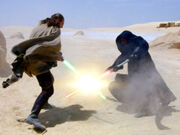
Two gladiators battle
The fights were widely popular in the Cilwellian Empire, largely because they reflected the Cilwelli lifestyle. The Cilwelli believed that suffering was the only way to enter the Afterlife. Therefore, the idea of blood sport was generally praised. However, some Cilwellians, particularly upper class females, viewed the games as inhumane and tried to outlaw them.
Typically, most gladiators were not natives to the Holy Cilwellian Empire. If the warriors were Cilwellian they were usually criminals condemned to death. Most gladiators were slaves captured by game organizers. Humans and Urgals were popular, due to the Cilwelli's hatred for these species. Wookiees were also popular, because of their incredible physical abilities. Sometimes, battle droids were used as gladiators.
There were many types of gladiatorial games. The most common was the conventional fights in which both warriors were armed with melee weapons and sometimes fought to the death. This category could be specified into two basic groups. The most common of these was irect. These games were often glamorized. The moves used by the gladiators were done more for show than practicality. Often these fights had pre-determined outcomes. Usually no one was killed, as fighters were instructed to wound their opponents. Sometimes, losing gladiators would actually play dead in order to create a more dramatic effect. Gladiators that fought in these irect games were usually Cilwellians, Wookiees and sometimes Force-sensitives.
The secound type of main combat was known as huze. These fights were customarily more violent than irect games. Often the gladiators that took part in these games were considered disgraced. Humans, Urgals, and criminals made up the majority of huze gladiators. Many fighters were slaves forced to fight in the arena. Unless he showed a great bravery during the fight, the winner was usual executed right after the match.

A gladiator fights kull
Another popular style was a fight between two beast or a gladiator and a beast. Animals such as kull, rancors, nexu, akk dogs, and reeks were commonly made to fight. When two creatures fought each other, bets were usually taken prior to the match. The winner could receive a fair amount of money. It was not uncommon for gamblers to rig fights. Professional gladiators never fought against beasts. Only condemned criminals and slaves were forced to combat animals. They wore no armor and often fought completely naked. The criminals would usually use long pikes. Most of the time, the fights ended with the beast being slain.
However, other times the fighter would be made to fight the creatures without any weapons. Sometimes these "fighters" were even tied to pools. This style of gladiatorial combat probably originated in the form of slave hunting. In these games, a dozen slaves were released into a pit of dangerous creatures. Onlookers would cast bets as to which slave they thought would last the longest. Sometimes, if a slave did exceptionally well, organizers would kill the beasts and spare the victorious slave. Often times, these slaves were made official gladiators. Most slaves that participated in the events were either ill or disobedient, and therefore no longer any use to their masters. Slave owners were usually paid to donate slaves to the arenas.
Tarboe arenas were also quite popular. They were usually smaller games that were owned by cantinas or mainstream arenas. They were unique, because only children participated. Customarily they were children who had broken some local law or ordinance. Because the Cilwellian government forbid the courts to punish minors, the Crex would use the tarboe arenas as loopholes to made sure children were sufficiently disciplined. Sometimes the youth were simply thrashed by their tarboe in front of onlookers. Other times, they were made to fight one another. The youthful gladiators weren't to kill each other. Rather, they fought with neuronic whips and wore masks made of a plant called yussu. Yussu masks could not be removed unless they were wet. The idea was that the young fighters would whip each other until one began to cry. After enough tears were shed, the yussu mask would come off. The last one to be wearing a mask was the winner.
Another popular style was space combat. This style was very popular among wealthy Cilwellians. Gladiators would fight in various types of starfighters. Often these fighters were fast moving crafts without hyperspace capabilities. Sometimes the dogfights would take place above an arena. The arena would be enclosed with two energy fields. One field was between the gladiators and the grand stands, while the other kept the fighters from flying away. The energy field between the competitors and the audience was to make sure none of the fans were injured by falling debris. Other times, rich fans would pay to be taken aboard cruise liners where they could watch gladiators fight in Outer Space.
Because of the Cilwellian's fascination with the mysterious elements of the universe, fights between Force-sensitives became very popular. Editors would higher Jedi or other Force-sensitives to compete in the games. Dark side powers were generally considered more exiting and therefore encouraged to be used. This made many Jedi wary of the sport. Most Jedi who did participate were young padawans, told that the games would bring them fame and fortune. These promises were very rarely fulfilled. Most Force-sensitive gladiators were either hired before the Jedi could recruit them, or taken from other Force-sensitive organizations.
Marriage and family
Because of the Cilwellians' short lifespan, the marriage process began at a relatively early age. On their fifteenth birthday, both male and female Cilwelli would begin wearing suggestive clothing, as a sign of their availability. The actual process of choosing a mate was very strenuous. First the father of a maid would invite ten young men to attempt to win his daughter's hand. After the men presented themselves, the desired woman would handpick five of her father's ten nominees. These five remaining candidates would be subject to all manner of physically and mentally challenging tasks. These tasks were designed to test the young men's ability to provide for their future wife. These tests lasted upwards of five months. Throughout this time the maid and her family would begin dismissing men who did not live up to their expectations. Eventually only one would remain.
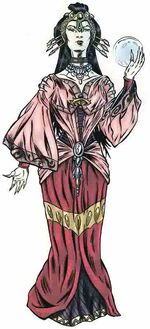
A female Cilwellian in a traditional wedding dress.
The actual marriage ceremony was conducted in the home of the groom. Both a witch and a warlock would attend the service. They would council the couple, as well as conduct the ceremony. The bride would be dressed in a colorful garment and would hold a crystal ball, which symbolized her virginity. The groom would ware similar raiment.
The wedding would begin with the Vranga reciting a prayer. To ensure that the couple would not dishonor Graef, the witch and warlock would lightly flog the couple. Next the couple would swear sacred oaths. Afterwards, the witch would order the bride to hand the crystal ball to the groom. At the warlock's command, the groom would then crack the ball in two with a metal hammer. One half would be given back to the bride the other would be kept by the groom. From then on the couple was officially considered man and wife.
After the wedding, a feast was held which would last ten days. Despite the fact that they were considered married, the husband and wife were kept from each other during the feast. Each was sent to mingle with their new spouse’s family. After the feasting, the couple would be locked away in a small hut, where they would spend the first night together. Traditionally, family members would wake the couple in the morning, by throwing a pan of cold water into the hut.
In Cilwelli culture, there strict limitations as to who a person could marry. The couple had to be from the same clan. This law was the most heavily enforced. Failure to abide by the law often resulted in death. Another well-known law stated that a man could not marry a woman older than himself. A female Cilwelli could not marry a male that was poorer that her.
Adultery was strictly prohibited. If a husband or wife was found to have a sexual relationship was another person, he or she would be taken before the Crex. If found guilty, the lover would be thrown to the Kull. The other adultery would be made a slave to the faithful spouse.
Cilwelli families were composed of many children. These children were educated in the ways of their clan. Children in the Low and Middle Clans were taught by the parents. Those in the High Clans went to special schools were they learned how to carry on the traditions of their predecessors. If a woman was unable to produce more than five children, than the husband had the right to marry a second or even third wife. These additional wives could be from any clan and were called aunts. Aunts were not to have a personal relationship with their husband, but were to simply act as producers of children. Likewise they were to be submissive to the First Wife.
The Zargayus Doctrine was carried over into the family. Each family member had a specific role which they were expected to carry out. The father was the provider of the family. He preformed the duties of the clan and was generally considered the leader of the home, through his title had little practical impact. The mother's primary duty in the home was to educate her children. The extent to which the children were educated varied from clan to clan. Children born into High Clans were often combined into a single classroom setting, where several mothers would educate all the children. In the Middle and Low Clans the women simply taught their offspring the essentials. In the case of the Vexhor, the children received no education what so ever, as the slaves' only duty was to serve their owners.
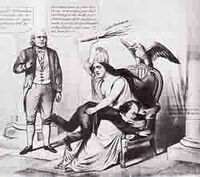
A tarboe disciplines a child, as the child's father looks on.
Each child also had a distinct role in the family. The eldest daughter and son were called tarboes. They were the disciplinarians of the family. They carried a small tree branch with them at all times, as a symbol of their authority. The eldest daughter was instructed to discipline her siblings, including the male tarboe. The eldest son would punish the female tarboe. But more commonly, he would discipline his own parents when he believed they had disobeyed the law or tried to gain more authority over the children.
When the tarboe were first born, they were sent away to live with the clan patriarch. The purpose of this was to ensure that they would not grow emotionally attached to their birth family. The patriarch would train the children the arts of their post. This evolved teaching them legal and religious laws, so that they would enforce them in their household. Before the tarboe were five years of age, the family simply did not have disciplinarians.
The second oldest son, or elpho, was the protector of the family. He made sure that the family was safe from wild beasts and sentient foes. The elpho was commonly seen guarding the entrance to the family's home. He would often carry a small spear or stick. Sometimes he would stand in the door way all through the night, with only a few hours of sleep. The second eldest daughter looked after the rest of the family. She fed them and cleaned them and preformed other such acts. The younger children were little more than slaves in the household. They did all the chores and lived only to serve their peers.
Education
Education was a very important part of the Cilwellian Empire culture. Mothers would often teach their children basic crafts and arts. At the age of six, children were required to attend public schools. These schools were often called propaganda schools by outsiders. At these schools, students would learn about Cilwellian culture, religion, and law.
These schools generally lasted all day long. Students would get up early and would not return home until after sunset. Excellence and obedience was expected of the students. Those who did not meet these expectations were punished. The degree and type of punishment varied. Sometimes students would be required to stand in front of the class while the other students through mud balls at the punished pupil. Other times pupils undergoing discipline would not be allowed to eat that day.
Corporal punishment was common. Students were commonly punished in front of their classmates. Teachers would beat the children with a rod or stick, usually on the bare arms, back, hands, buttocks, or legs. The spankee would customary go across the disciplinarian’s knee or lap or lean against a wooden stool. Sometimes, the punished pupil would be tied down.
Other times, students would locked away in empty rooms for a given amount of time. Some students would try to escape while under detention. Escape attempts were always punished with beatings. However, punishments were not usually considered this extreme. Normally, punished students would simply be forced to stand in an uncomfortable position for a certain amount of time. Other relatively less severe punishments include being made eat a bitter or spicy food.
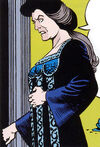
Olisa Aulsur, leader of the Cilwellian Education and Instruction Administration
According to the Zargayus Doctrine, only women were allowed to teach children. Most women teachers came the Aulsur clan. However, some witches were also teachers. The witches would instruct the students on spiritual matters. It was likely Zargayus who formed the Cilwellian Education and Instruction Administration This organization was a group of women who oversaw the education of the next generation. They also made sure that the things being taught in the propaganda schools were in concordance with the laws and traditions of Cilwelli. In the later years of the Holy Ciwlelian Empire, the CEIA also created a "school laws." This was a set of rules and regulations for both teachers and students. There was also a set of pre-determined punishments that went also with the law. The CEIA also made sure that all parents sent their children to the propaganda schools. Failure to do so resulted in stiff punishment.
The textbooks were actually clay or stone mats. These mats were usually written by Vrangain scribes. Sometimes, teachers had to write their own textbooks. Some local businessmen began to sell textbooks. Because most of these book sellers were men, the CEIA saw it as an offense to the Zargayus Doctrine and closed down the book stores.
Economy
The economy of the Cilwellian Empire was closely regulated by the Aulsurs. Individuals could not buy, sell, or trade without permission from the government. Moreover, they had to buy or sell when instructed to. This was due to the fact that each clan only produced one major product. Therefore, if the trade of these goods was not regulated one clan could end up with a disproportionate supply of goods. For example, a clan could have many slaves but no food.
Each clan was responsible for producing their products. The Sevvel and Hyt clans were in charge of gathering food. The leaders of the Vexhor clan sold their own members into slavery as the Empire's means of gaining slaves. Twenty percent of these supplies were given to the Aulsurs as taxes. Ten percent was given to the Vranga as tithes. Then, under careful direction by the Aulsurs, the clans traded with one another for necessary goods.
The Auslur had a special group of law enforcement officers called bazaar police which made sure the various clans conducted trade and commerce according to Cilwellian law. Often the police would act as intermediates, selling and buying supplies as representatives of different clans.
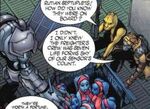
The smuggling of slaves was not uncommon in the Cilwellian Empire
There was no official currency in the Holy Cilwellian Empire. Members of the High Clans sometimes used nova crystals as money. Nova crystal was also used by Cilwellians to trade with outsiders. However, this was rarely necessary as the Empire's economy was largely autonomous.
Slavery was a large part of the Cilwellian economy. Slaves were one of the Empire's few exports. People from the Republic who were seeking slaves would often go to Cilwelli or Hustia, purchase the "merchandize", and then return to Republic space. Smugglers would also ship their cargo into places were slavery had been outlawed. Many criminal organization were based on Cilwelli. The Holy Empire had very laxed standards concerning actions that were considered crimes by other governments.
When the Empire first began, the economy was very unstable. During the rebellion against the Infinite Empire, the Cilwellians had destroyed many of the planet's natural recourses. It was years before the economy was able to stabilize. Zargayus spent a large amount of his rule attempted to improve the financial conditions of the people. He believed that the caste system would help keep social elites from spending wastefully.
However, any progress Zargayus may have made was reversed by the numerous holy wars that followed his reign. The war exhausted many of the Cilwellian Empire's recourses. During the wars, the taxes were greatly increased. Most of the Cilwellian citizens' profits went to finance the war effort. After the war end, the Aulsurs again began to work on revitalizing the economy.
The Imperial economy got a boost after the Hutts assisted them during the Hutt-Xm War. The alien crimelords gave pieces of their wealth to the Aulsurs. Likewise, they set up many businesses and modern facoties on Cilwelli, which furthered aided the economy. However, these financial aids cost the Cilwellians their freedom.
Astrography

The Holy Cilwellian Empire was relatively small. It consisted of two planets and four moons. Only three of the moons were inhabitable. The Cilwellian Empire also owned a large asteroid field. Workers mined minerals from the field, but over all, the asteroid belt was largely uninhabited.
Cilwelli: From the time the Empire was founded, Cilwelli was its capital. It had the largest population of any other planet in the Holy Empire. Moreover, it was the birthplace of the Empire's founding species. Mountains dominated the landscape. There were at least five oceans throughout the planet. Several inhabited island-states dotted the waters. Cilwelli City was located by one of these oceans. The government palace was nestled within the metropolis.
Ecka: Cilwelli had three moons. Cilwellian spacers began establishing settlements on these moons during their quest for expansion. Ecka was the first moon to be colonized. It had no sentient natives and was easily established as part of Cilwellian society. Its moderate climate and jungle scenery was in stark contrast to the rough landscape of Cilwelli. Many wealthy Cilwelli built homes and recreational parks on Ecka. The moon soon had a reputation as the "Snob's Moon."
Vextor-1: The second moon to be colonized was Vextor-1. However, Vextor-1 was far different from Ecka. It was covered in ice and snow. A few settlers braved the cold, but most left.
Vextor-2: Vextor-2 was the last moon to be settled. Its landscape was much like Cilwelli's. The rocky ground made farming difficult and raising livestock hard. Only a few Cilwellian remained on the moon after its discovery. The Holy government began sending slaves and criminals to the moon as punishment.
Hustia: Hustia was the only other planet in the Cilwellian Empire, besides Cilwelli itself. It originally belonged the Urgal people. However, it was captured by the Zargi. The Urgals were enslaved and the planet became an Imperial colony. It was lush and tropical. However, the heat and humidity detoured visitors.
Yuuzi: Hustia had one moon. Yuuzi was gaseous and uninhabitable.
Astroid belt: Surrounding the Cilwelli system was an asteroid field. A few spacers set up camps on asteroids. They mined minerals from the giant rocks. However, few only about a seventy people inhabited the belt.
Government
Executive branch
The Cilwellian government was run by the Aulsur clan which was in turn run by a patriarch. The patriarch, called the Aulsur, would be elected by the members of the clan. The Aulsurs commanded the army, made laws, and saw that these laws were enforced. The Aulsurs were said to be children of the god Graef. Therefore, the Aulur were highly respected by their people. Some were even worshipped.
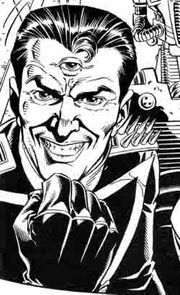
Dezlar Omus, the first Auslur
The government was headquartered in Cilwelli City. High ranking Aulsurs lived in a palace in the center of town. The palace was spacious and overlaid with nova crystal. It was in this castle that the leaders would meet and discuss the making of laws and the state of the Empire. Laws were posted in every city in the Cilwellian Empire. Customarily, the new laws would start being enforced thirty days after they were posted, to ensure that everyone had the chance to read them.
The entire Aulsur clan had the authority to make laws. A member of the clan would bring a bill before the rest of the family. The clan would then vote on whether or not to pass the proposal. Traditionally, the First Lady would oversee meetings between the clan members. She would make sure that the councils were civil and orderly. The clan patriarch also had the authority to make laws and ordnances. However, he did not have to bring his proposals before the rest of the clan.
For the most part, the Aulsurs could do as they pleased. Their power was total and strictly enforced. The only check to the monarchy's power was the Vranga. The Vranga had religious authority on Cilwelli. If they believed that the Aulsurs were defying holy law or Cilwellian tradition, they could step in and replace the current king. Because of this, most Aulsurs tried to befriend the Vranga.
Judical Branch
The Crex were in charge of making sure the laws created by the Aulsurs were enforced. The Aulsurs would determine the methods in which the officers were to employ. Primarily, corporal and capital punishment was used by the Crex. They each carried rods and an axe. The rods were used to beat criminals and the axe as used to execute them. Other methods included putting convicts into stocks or dunking stools. This was designed to humiliate those who had broken the law. Likewise, this in turn, was suppose to keep others from violating Cilwellian law.
However, the Crex were not allowed to simply punish Cilwellian citizens at random. Any member of the High or Middle Clans had the right to ask for a parlay. If an individual requested parlay then the Crex were required to hear their case. Often the Crex patriarch would be the one to listen to the suspect's pleas. If the patriarch found that there was evidence in the defendants' favor, then the suspect would be declared innocent. However, if the judge found that the person was guilty, then their punishment would be doubled. Most Cilwellians opted to bare the original sentence.
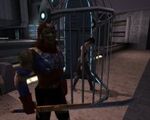
A Crex guards a prisoner.
The Judge would use several methods to determine if the suspect was guilty. Often he or she would draw lots. Supposedly, the lots would show the will of the gods. Other times, the patriarch would have the person on trial fight a Crex. If the Crex won then the person was guilty. If the suspect won then he or she was innocent. Because of their superior training, the Crex usually won these matches. Perhaps the most common methods of determining guilt or innocence was to throw the defendant into a pit of kull. If the kull killed the suspect the he was considered guilty. But he was spared then he was free.
The Crex were not the only enforcers of Cilwellian law. The Vranga were allowed to try religious cases. The warlocks and witches would often convict citizens of blasphemy and heresy. Likewise, the Vranga would punish offenders. Witches in particular were known for beating people for failure to attend prayer or other religious functions.
Military
The Zargi clan made up the Holy Cilwellian Empire's military. The Zargi were founded as an independent clan prior to the Empire's formation. From the start they were considered warlike. The clan leaders converted to Zargayusism and joined Zargayus' Empire. Becuase they were seemingly more skilled in the art of warfare than the other clans, they were made the primary defenders of the Cilwellian Empire.
Young Zargi began their training almost from birth. A child would first be inspected by clan leaders to see if he or she was physically fit for the task. If, for any reason, the clan leaders determined that the child was unfit the child would be killed. Both males and females fought in the Cilwellian army.
After passing inspection, the trainee would go through a series of strenuous tasks to build up his or her strength. Sometimes the young Zargi would be beaten in order to increase their tolerance toward pain. Turning this time, the Zargi were also taught the ideology of the Cilwellians. The Zargi would a strict honor code. Warriors could take prisoners, but they were not allowed to harm them. Likewise, Zargi could not harm women. This did not stem from a sense of chivalry or respect, but because women were suppose to be symbols of morality acceding to Cilwelli tradition.
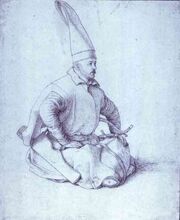
A Zargi officer
The Zargi had an orderly chain of command. The Zargi were a military unit, however, they were also a family unit. Because of this, officers were often referred to as Father or Mother. Warriors would refer to their equals as Brother or Sister, depending on gender. Those of lower rank were called Children. The command-in-chief was the Grandfather. Likewise, there was at least one Grandmother in Cilwell's history. The Zargi were extremely loyal to the High Clans. The Grandfather took orders from the Aulsur. The Grandfather would then pass ordered on to his troops.
The weaponry of the Cilwellian military varied. Originally, the Zargi used simple weapons such as vibroswords and primitive spears. An Urr inventor learned how to use heat to make a crude laser. However, these lasers were only used on Cilwellian starfighters. This was largely due to the fact that the primitive laser cannons were too large for practical use on the ground. As the Cilwellian Empire began to trade with other societies, new technologies were brought into the Empire. Blasters began to became common Zargi weapons.
Armory and uniform was very diverse among the Zargi. Many of the warriors wore some form of armor. The armor was made from animal skins, metals, and other substances. Fathers and Mothers often wore long, heavy robes to provide protection and to appear dignified. Some soldiers would fight completely nude in order to show their supposed bravery.
Behind the scenes
The Holy Cilwellian Empire was created by Red Head Rider. The article's name was based on the Holy Roman Empire. It is worth noting that the Holy Cilwellain Empire does not appear in any of RHR's original works concerning the Cilwelli people, namely Cilwelli (species) and Gladiatorial combat. The idea to create an organized pre-Republic empire came to Rider after those articles were written. He is considering rewriting portions of other articles in order to unify his continuity.
Much of the military section was inspired by the Ancient Spartans and Celts. The uniform of the Crex was based off the Roman facets. Originally, the Cilwelli were suppose to look similar to Chiss. But his idea was dropped in hopes of creating a more original appearance for the Cilwelli. In the end, Trioculus was used as a model for the Cilwellians.
The Cilwellian faith was based on Native American and Pacific tribal religions. The idea to have two central deities, one good and one bad, was inspired by the concept of Dualism. Bharlon's appearance is based on the Babylonian harlot.
A couple of readers have noted that there is a similarity between the Cilwellian clans and the Hindu castes. However, Hinduism did not serve as the original inspiration for the Cilwellian castes. The idea actually came from some of the economic methods used by the Soviet Union. After the concept was created, however, RHR used the Hindu caste system to formulate the details of Cilwellian clans.
